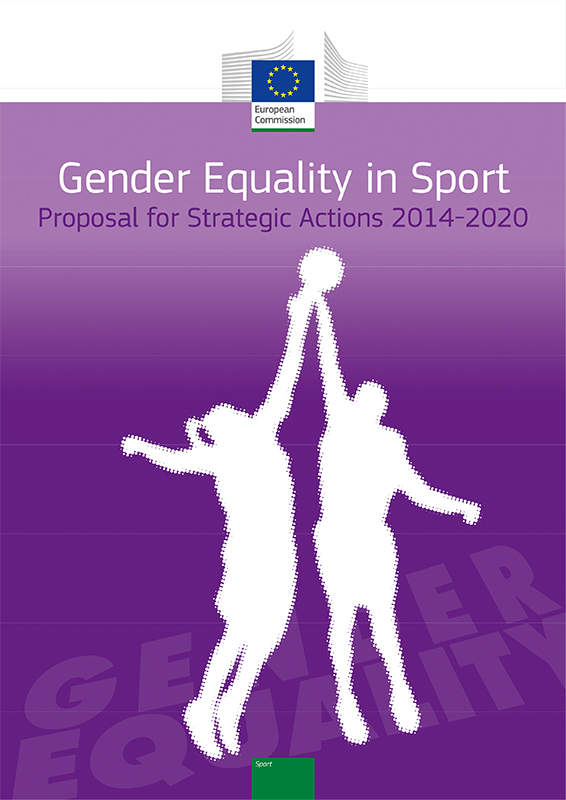Eesti keeles: Euroopa Komisjoni strateegiliste meetmete ettepanekud aastateks 2014-2020
Euroopa Komisjon 2014
Preface
Although we are witnessing more and more women in Europe participating in sport activities, a lot remains to be done in the sphere of gender equality. Many women are today still unable to find the right environment in which to develop their full potential. In some countries, women lag seriously behind men in access to sport.
We know that many factors, external to sport, can affect women's levels of participation. These include the situation at home or the role of physical education at school. But we also know that there are many factors at play within the sport sector itself which can hamper the participation of women - for instance the lack of coaches which create a gender friendly and safe sport environment, no interest from decision-making boards, often dominated by men, for sustainable gender equality policies leading to concrete changes.
The importance of sport in our daily life cannot be overstated. It contributes significantly to fitness, health, the economy and self-development, teaching us values and skills like discipline, teamwork, respect and perseverance. It is all the more regrettable, therefore, that the sport world should still be plagued by inequalities between women and men.
I am determined to promote gender equality in sport and also to use the potential of sport for equality in its broadest sense. A gender-friendly climate should become a standard feature of sport institutions and I have no doubt that the sport world will be the first to reap the benefits.
I therefore welcome this report as an invaluable input into the political debate which I am confident will lead to the implementation of concrete actions at national and European level.
Androulla Vassiliou
EU Commissioner for Education, Culture, Multilingualism, Youth and Sport
Contents
1. Gender equality in sport
1.1. Introduction
1.2. Challenges for gender equality in sport
1.3. Benefits of gender equality in sport
1.4. A call for strategic actions for the promotion and support of gender equality in sport
2. Call for the development and implementation of national and international strategies
2.1. Need for strategic actions at national level
2.2. Need for a Europe an approach
3. Gender balance and equality in decision-making in sport
3.1. Challenges at national and international levels
3.2. Objectives 2020
3.3. Tools and measures to implement the objectives
3.3.1. Gender balance on executive boards and committees of sport governing bodies
3.3.2. Gender balance in the management of professional sport administrations and governing bodies
3.3.3. Gender equality policy in sport governing bodies
4. Gender equality in coaching
4.1. Challenges at national and international levels
4.2. Objectives 2020
4.3. Tools and measures to implement the objectives
4.3.1. Gender balance in the coaching workforce as volunteer and employed coaches
4.3.2. Gender balance of female and male coaches in all national teams
4.3.3. Evidence based knowledge about gender and gender equality is included in coach education
5. Fight against gender based violence in and through sport
5.1. Challenges at national and international levels
5.2. Objectives 2020
5.3. Tools and measures to implement the objectives
5.3.1. National strategy in each EU Member State
5.3.2. Preventive tools and supporting service for victims
5.3.3. Human resource policy on volunteers and professionals
5.3.4. Programmes in sport to empower girls and women against possible harassment and abuse
6. Fight against negative gender stereotypes in sport and the role of the media
6.1. Challenges at national and international levels
6.2. Objectives 2020
6.3. Tools and measures to implement the objectives
6.3.1. A fair portrayal of both women and men in the sports media
6.3.2. Gender balance in the coverage of sport inall media
6.3.3. Gender balance of women and men working in European sports mediadepartments
7. Horizontal tools and measures
7.1. Introduction
7.2. Challenges at national and international levels
7.3. Tools and measures to implement the actions
7.3.1. Public awareness and dissemination
7.3.2. Networks and partnerships
7.3.3. Research, monitoring and evaluation
7.3.4. Gender mainstreaming
7.3.5. Financial support
ANNEX I
Glossary
Gender
Gender-based violence
Gender equality
Gender equity
Gender-based harassment
Gender identity
Gender Roles
Intersectionality
Multiple discrimination
Sexual abuse
Sexual harassment
ANNEX II Example of Guidelines for a National Action Plan on gender based violence in sport
ANNEX III List of experts
Notes

